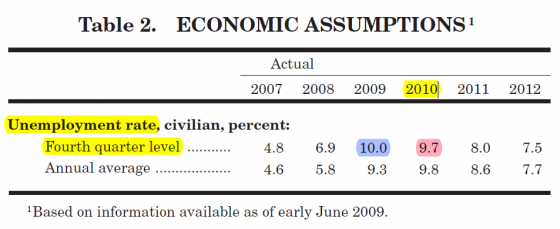I want to continue to focus on the new economic projections from OMB and CBO. Here is some basic background:
- The unemployment rate in July was 9.4%.
- Most economists consider “full employment” to be in the 4.5% – 5.5% range.
- There are now about 154 m people in the workforce, so each tenth of a percentage point on the unemployment rate is about 150,000 people.
- This means July’s 9.4% unemployment rate translates into about 14.5 m people who want work but don’t have it.
- Rule of thumb: Because the labor force grows over time, the U.S. economy needs to create about 100K – 150K net new jobs each month for the unemployment rate to stay constant. For the unemployment rate to decline you need to exceed that range.
- The U.S. economy lost 247,000 jobs in July.
On Friday, August 7th the President spoke in the Rose Garden. He said:
Today we’re pointed in the right direction. We’re losing jobs at less than half the rate we were when I took office.
I wrote earlier about why this is the wrong way to analyze it. Now I want to compare the President’s language with his Administration’s new projections.
Here is an excerpt from Table 2 on page 11 of the Mid-Session Review, released Tuesday by the President’s Office of Management and Budget:
The blue highlight shows that the Administration projects the unemployment rate in the fourth quarter of this year will be 10.0%, six-tenths of a percentage point higher than it was in July.
The red highlight shows that the Administration projects the unemployment rate in the fourth quarter of next year will be 9.7%, three-tenths of a point higher than it was in July.
I draw two conclusions from this table:
- This is not “headed in the right direction.”
- If the Administration’s projection is correct, the unemployment rate will be in the high-9s during the next election and it won’t be coming down quickly.
The last point surprised me. The Administration projects the unemployment rate will decline by only three-tenths of a point from the fourth quarter of this year to the fourth quarter of next year. That’s not good.
Looking at another part of the same table, they project GDP will grow in 2010, either 2.0% or 2.9% depending on how you want to measure it. But it appears they project employment growth to be slow enough that the unemployment rate will decline very slowly throughout 2010.
The only explanation I can find to square this projection with the President’s language is footnote 1 above. Between early June and early August we had six weeks of economic data, some of which was positive. Still, I would be surprised if the Administration would rely on this new data to disclaim the forecast they published just this week.
I think the President and his team will have a tough time arguing that the stimulus is having the desired effect as long as the unemployment rate continues to climb, and even when it begins to decline if it does so slowly. The Administration will of course argue that things would be worse if they had not done the stimulus. That’s a tough message to sell when the unemployment rate is in the 9s or 10s.
I need once again to remind you that nobody really knows what next year will look like. These are all just educated guesses.
CBO does not publish projected fourth quarter levels, so we can’t compare their projections. They do project the average annual unemployment rate, and their projections are slightly more pessimistic than OMB’s. OMB projects an average annual unemployment rate next year of 9.8%. CBO projects 10.2%. The Blue Chip survey of private forecasters projects 9.9%.
There seems to be a disconnect between the President’s language, which is raising expectations that things will get better in the near future, and his Administration’s economic projections.
If these projections are realized I imagine they will affect significantly the 2010 election. If the unemployment rate is in the 9.5% – 10% range on Election Day, and if it is declining as slowly as the Administration projects, there could be a big effect in the voting booth.
(photo credit: Library of Congress)
